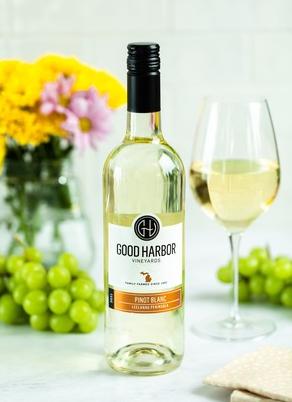What is a Dry White Wine: Guide to Your Perfect Sip
Wine aficionados and casual sippers alike appreciate the crisp allure of a dry white wine. Yet, the world of white wines can be bewildering, with an array of flavors, grape varieties, and origins.
In this comprehensive guide, we demystify what is a dry white wine, exploring what characterizes them and what makes them special. From Chardonnay to Sauvignon Blanc, you'll gain insights into the different types of dry white wines and the art of food pairing, revealing how to elevate your culinary experience with the ideal dry white wine. Plus, we've curated practical tips for how to choose the perfect dry white wines. So, let's embark on a flavorful journey through the world of dry white wines.

What is Dry White Wine?
Dry white wine, a delightful and versatile libation, charms the palate with its lightness, crispness, and balanced acidity. The key to its dryness lies in the fermentation process, where yeast transforms grape sugars into alcohol.
A dry white wine contains minimal residual sugar, usually less than 1%, equivalent to approximately 4 grams per liter. Esteemed examples like Chardonnay, Sauvignon Blanc, and Champagne embody this style, characterized by their bright acidity and a striking absence of sweetness. Unlike their sweet counterparts, dry white wines bring forth herbaceous, grassy, and citrusy notes, adding an invigorating dimension to each sip.
Different Types of Dry White Wine
Now that you understand the essence of dry white wines, let's explore the captivating diversity within this category. From medium-dry white wines to the driest of the dry, there's a wealth of options to suit every palate and occasion.
Medium Dry White Wines
Medium dry white wines, containing approximately 5-12 grams of residual sugar per liter, offer a balanced spectrum of flavors. Among these, you'll encounter:
- Riesling: A German gem celebrated for its apple, pear, and stone fruit notes. Riesling's versatility spans from dry to sweet, accommodating various preferences.
- Viognier: This rising star on the global stage delivers lower acidity and luscious, fruit-forward flavors. With hints of tangerine, peach, and notes of vanilla and warm spices, Viognier's creamy palate is reminiscent of an oak-aged Chardonnay.
- Pinot Blanc: Emerging from the white grape mutation of Pinot Noir, Pinot Blanc thrives in Germany, Italy, France, and Austria. Known for its high acidity, it responds splendidly to oak aging, presenting flavors of sour cherry, citrus, peach, and raw almond.

Very Dry White Wines
So what is considered a dry white wine that is very dry? These wines are celebrated worldwide for their crisp and refreshing profiles, marked by bright acidity and fresh flavors. At the forefront of this category are popular favorites, each offering its unique character.
- Sauvignon Blanc: Often considered the international standard for dry white wine, Sauvignon Blanc hails from Bordeaux, France, and has garnered fame on the global stage. This wine is celebrated for its pronounced grassy and herbaceous notes, along with hints of bell pepper and gooseberries.
- Chardonnay: This time-honored French classic has found a home in vineyards across the globe. It presents itself in two distinct styles: unoaked and oaked. Unoaked Chardonnay features tropical fruit and earthy hints, all underscored by sharp acidity. In contrast, oaked Chardonnay unveils buttery and vanilla flavors, accompanied by a rich, creamy texture.
- Muscadet: Crafted from the Melon de Bourgogne grape variety in the Loire Valley, Muscadet stands as a very dry white wine. It delights with its light body, crisp acidity, and fruity essence characterized by notes of citrus, tart apple, and mineral undertones.
- Torrontés: This wine, especially beloved in the vineyards of northern Argentina, unfolds with a fresh and captivating peach aroma and a smooth, textured palate. The high-altitude vineyards of this region distinguish Torrontés, making it a unique and enticing choice.
- Albariño (or Alvarinho): Originating from the coastal regions of the Iberian Peninsula, this wine offers vibrant acidity and a refreshing array of flavors, including citrus, stone fruit, and a touch of salty minerals. These characteristics make it an ideal partner for seafood or for sipping during a sun-soaked day at the beach.
- Sémillon: As the third most planted white wine variety in France, after Sauvignon Blanc and Chardonnay, Sémillon captivates with notes of citrus, encompassing lemon, lime, and grapefruit. In warmer climates, it reveals flavors and aromas of ripe fruits like mango, peach, and papaya, sometimes with a hint of moderate oak aging, imparting buttery notes akin to an oaked Chardonnay.
The Driest White Wines
If you're in pursuit of the driest white wines, your journey can lead to French Muscadet. Known for its very dry palate and robust minerality, This type of Muscadet's hint of citrus adds depth to this wine, making it a treasure for aficionados seeking unparalleled dryness.

Food Pairing with Dry White Wines
Dry white wines are celebrated for their versatility when it comes to food pairings. Whether you're savoring light and fresh dishes or indulging in vibrant and spicy fare, there's a dry white wine that's perfect for the occasion.
- Light chicken dishes - Find harmony with Sauvignon Blanc, Sémillon, or Chardonnay, accentuating the flavors with their bright acidity.
- Salads or herbaceous dishes - They become even more refreshing when paired with Sauvignon Blanc or Pinot Blanc, embracing the green notes and creating a symphony of freshness.
- Seafood - These dishes, especially white fish with a lemony touch, take on a new dimension with Sauvignon Blanc or Pinot Grigio, heightening the maritime experience.
- Spicy pasta dishes - Find a match in wines like Riesling, Torrontés, Viognier, or Gewürztraminer, tempering the spice and adding depth to the dish.
- Moroccan or Middle Eastern cuisine - This food is brought to life by Gewürztraminer, as it complements the aromatic spices and enhances the culinary journey.

Tips for Choosing Dry White Wine
Selecting the perfect dry white wine can be a delightful endeavor, but it's essential to consider a few factors to ensure you make the right choice:
- Consider Your Dish: The dish you plan to prepare should guide your wine choice. Light and delicate dishes pair beautifully with Sauvignon Blanc or Pinot Grigio, while more substantial meals, such as creamy pasta, are enhanced by Chardonnay or Viognier.
- Acidity Matters: Look for wines with bright acidity. Higher acidity levels can cut through the richness of many dishes, making them a versatile choice for cooking.
- Balance Is Key: Seek wines that strike a balance between dryness and flavor. Too much residual sugar can alter the character of your dish, so opt for wines with minimal sweetness.
- Quality Over Quantity: While you don't need to break the bank, choosing a reasonably priced, good-quality wine is essential. The wine should be drinkable on its own, ensuring it adds depth and nuance to your culinary creation.
Conclusion
In the world of wines, dry white wines stand as versatile and essential gems. With their delightful crispness and an array of flavor profiles, they are ideal for sipping on warm afternoons and creating culinary masterpieces. Understanding what is a dry white wine, from the fermentation process to the residual sugar content, empowers you to make informed choices for both cooking and sipping. Remember that the best choice often depends on your personal preferences and the dishes you're preparing. Ultimately, it's a delightful journey of discovery, where you can savor the crisp and bright allure of dry white wines in every glass and on every plate.
